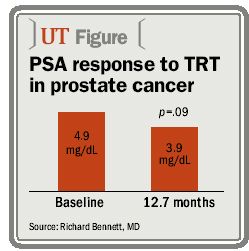Article
Testosterone replacement therapy may be viable treatment in men with prostate cancer
Testosterone replacement in men with prostate cancer is a viable treatment option to improve their vitality, according to several studies presented at the Sexual Medicine Society of North America 2008 Fall Scientific Meeting.

In one study of 57 hypogonadal men (ages 53 to 83 years) who were treated with testosterone on average 36 months after radical prostatectomy, the men experienced a statistically significant elevation in their testosterone values, but not their PSA levels. Men were followed for a mean of 13 months after receiving testosterone replacement. Treatment did not compromise patient safety, according to lead investigator Mohit Khera, MD, MBA, MPH, assistant professor of urology at Baylor College of Medicine in Houston.
"Although there were not significant rises in PSA values, these patients did experience improvements in their hypogonadal symptoms," he said. "However, longer, randomized, placebo-controlled trials are needed to assess the true efficacy and safety of treating men with testosterone after a radical prostatectomy."
Testosterone replacement therapy also demonstrated efficacy in hypogonadal men receiving TRT while on active surveillance for low-risk disease, according to a chart review conducted at Baylor College of Medicine, Houston, and Beth Israel Deaconess Medical Center, Boston.
In the study, 13 men (mean age, 63 years) with untreated low-risk prostate cancer received an average of 12.7 months of TRT during active surveillance. Data were evaluated relative to age, baseline and treated serum levels of total and free testosterone, PSA, prostate biopsy, and length of follow-up. Six men received TRT before prostate biopsy and continued with the therapy. Seven began testosterone therapy after receiving a diagnosis of prostate cancer.
"We can treat their hypogonadal symptoms while they are on active surveillance," said Richard Bennett, MD, a urology fellow at Baylor working with Larry I. Lipshultz, MD. "We tell patients that there is a theoretical risk [of their cancer progressing], but we tell them that they will be followed closely.
"If we observe a significant change in their PSA, for example, we can move them to surgery and out of active surveillance, similar to any other patient on active surveillance."
Mean PSA was 4.9 ng/mL prior to prostate cancer biopsy and 3.9 ng/mL at most recent follow-up on testosterone (p=.09). All 13 men responded to TRT without a concomitant significant rise in their PSA values or grade progression on repeat prostate biopsy. Follow-up prostate biopsies in six men showed no cancer in four patients, a Gleason score of 6 in one patient, and a Gleason 7 in one patient, with 5% involvement of one of 10 positive cores.
"These patients are active and healthy," Dr. Bennett told Urology Times, noting that the men can opt for surgery or radiation therapy if they change their mind or show signs of disease progression.
He cited six recent studies that have reported few recurrences with TRT in men following prostate cancer treatment.
In a retrospective analysis by scientists at the University of South Florida in Tampa, 20 men who had hypogonadal symptoms or decreased testosterone levels were administered supplemental testosterone after radical prostatectomy (14 men) or external beam radiation therapy (six men) for prostate cancer. Eight men received injections of testosterone, 200 mg every 2 weeks, and 12 received daily supplemental testosterone in a 5-gram transdermal gel formulation. PSA values were monitored closely.
Before initiation of testosterone after prostate cancer therapy, the men had to have favorable pathologic features such as negative surgical margins, undetectable PSA, and a normal digital rectal exam. The men reported benefit from both testosterone treatments.















